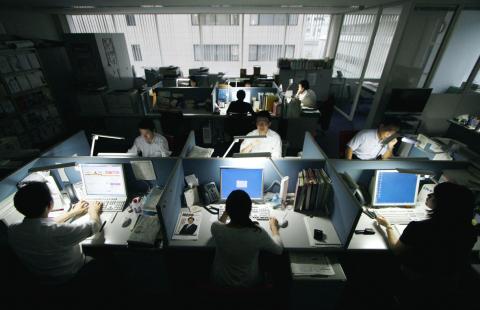The Japanese government yesterday called on homes and businesses to cut their energy use by as much as 15 percent amid fears that nuclear plant shutdowns would spark power shortages and blackouts.
With the coming of summer, Japan’s utilities are warning of a shortfall. Kansai Electric, which serves the commercial hubs of Osaka, Kyoto and Kobe, has warned it will be 15 percent short, with utilities in other areas expected to redirect any saved power to energy-starved regions, the government said.
Power providers in the northern island of Hokkaido and southern Kyushu have also warned they may not be able to meet demand, with customers in those regions being asked to cut energy use between 7 and 10 percent.

Photo: Reuters
A power-saving order was issued last year in the wake of Japan’s nuclear crisis sparked by the March 11 earthquake and tsunami.
However, yesterday’s call was not mandatory because it may put “too much of a burden on business activity,” Japanese Economy Minister Motohisa Furukawa told a press briefing.
The cuts last year, aimed at large energy users, sparked complaints from the business sector and fears it may prompt manufacturers to move production overseas.
Japan’s power-saving campaign will run from July through September, as Kansai and some other utilities prepare for scheduled blackouts.
The resource-poor country used to draw about one-third of its electricity from atomic power, but last year’s meltdown at the Fukushima Dai-ichi plant has generated anti-nuclear sentiment among the public
All of Japan’s 50 commercial reactors have now been switched off, and when — or if — they will be restarted remains uncertain.
Japanese Prime Minister Yoshihiko Noda said on Thursday he would soon make a final decision on restarting reactors at Oi in Fukui Prefecture.
Fukushima operator Tokyo Electric Power Co, which supplies Tokyo and surrounding areas, has said it expects to be able to meet demand this summer thanks to continuing power saving by businesses and households.
The cost of utilities has soared as companies turned to expensive alternatives to fill the gap left by the shutting down of reactors.

‘UNUSUAL EVENT’: The Australian defense minister said that the Chinese navy task group was entitled to be where it was, but Australia would be watching it closely The Australian and New Zealand militaries were monitoring three Chinese warships moving unusually far south along Australia’s east coast on an unknown mission, officials said yesterday. The Australian government a week ago said that the warships had traveled through Southeast Asia and the Coral Sea, and were approaching northeast Australia. Australian Minister for Defence Richard Marles yesterday said that the Chinese ships — the Hengyang naval frigate, the Zunyi cruiser and the Weishanhu replenishment vessel — were “off the east coast of Australia.” Defense officials did not respond to a request for comment on a Financial Times report that the task group from

Chinese authorities said they began live-fire exercises in the Gulf of Tonkin on Monday, only days after Vietnam announced a new line marking what it considers its territory in the body of water between the nations. The Chinese Maritime Safety Administration said the exercises would be focused on the Beibu Gulf area, closer to the Chinese side of the Gulf of Tonkin, and would run until tomorrow evening. It gave no further details, but the drills follow an announcement last week by Vietnam establishing a baseline used to calculate the width of its territorial waters in the Gulf of Tonkin. State-run Vietnam News

Four decades after they were forced apart, US-raised Adamary Garcia and her birth mother on Saturday fell into each other’s arms at the airport in Santiago, Chile. Without speaking, they embraced tearfully: A rare reunification for one the thousands of Chileans taken from their mothers as babies and given up for adoption abroad. “The worst is over,” Edita Bizama, 64, said as she beheld her daughter for the first time since her birth 41 years ago. Garcia had flown to Santiago with four other women born in Chile and adopted in the US. Reports have estimated there were 20,000 such cases from 1950 to

DEFENSE UPHEAVAL: Trump was also to remove the first woman to lead a military service, as well as the judge advocates general for the army, navy and air force US President Donald Trump on Friday fired the chairman of the Joint Chiefs of Staff, Air Force General C.Q. Brown, and pushed out five other admirals and generals in an unprecedented shake-up of US military leadership. Trump wrote in a post on Truth Social that he would nominate former lieutenant general Dan “Razin” Caine to succeed Brown, breaking with tradition by pulling someone out of retirement for the first time to become the top military officer. The president would also replace the head of the US Navy, a position held by Admiral Lisa Franchetti, the first woman to lead a military service,